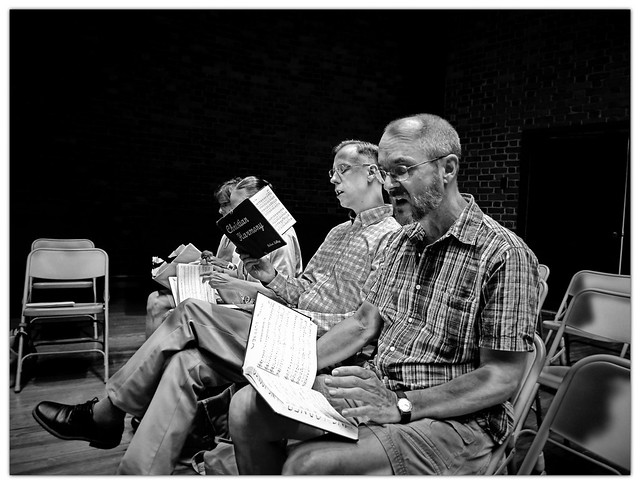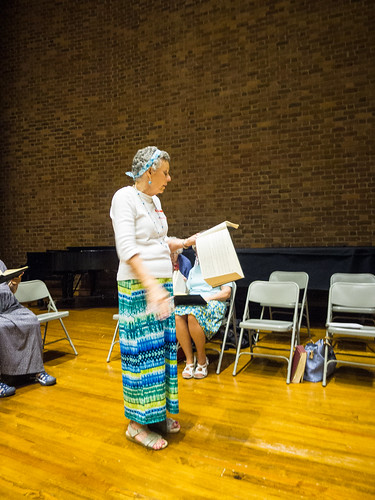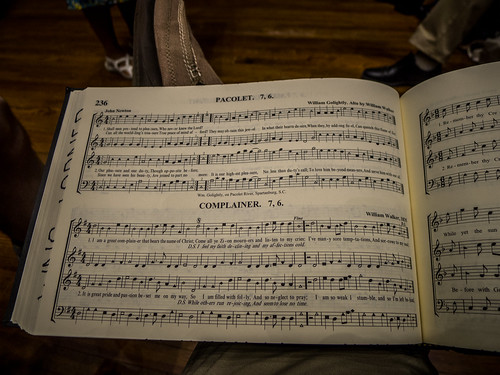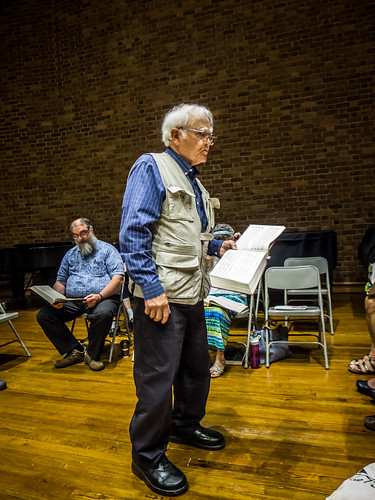Saturday was one of those busy days where I needed to be about five people. Between potential paddling trips, Artisphere, Furman graduation, and other local festivals, there were lots of choices. I decided to head over to Furman for the 2015 Nan Herring Shape Note Singing.
The Nan Herring Singing is held each year on “the Saturday before the Second Sunday,” using the parlance of the singing community. This year and last year the date conflicts with Furman Graduation. This was not the case before Furman went on a semester system and graduation was in early June. The last time I came to this singing was in 2008, before the change, and we were able to use Herring Hall, where we rehearse for Chorale. This time, due to conflicts with the Furman Singers needing their home space, we held the singing on the stage of Daniel Recital Hall.
I almost didn’t come to the singing because of all the potential conflicts. There would be parking issues because the baccalaureate service was being held next door in McAlister Auditorium. A luncheon for graduates and family was being held on the other side of the auditorium on the grounds of the art building. A shape note singing just seemed…out of place, given everything else that was happening.
I arrived early, and it turns out I had the parking lot pretty much to myself, at least for the time being. I helped Dave Farmer and a couple of others set up chairs on the stage for the singing, and soon other participants started to arrive.
I also took the time to set up recorders all around the group. My intent was to capture the audio from different angles so I could mix a good recording. I was also hoping to get some interviews from the participants for my podcast.
As the group gathered I recognized several of the singers. In addition to Dave, I’d met Leon and Frances Carnell at the singing a couple of weeks ago. Robert Kelley was there, as was Bill Burns, whom I’d met at other singings. I recognized other faces, but couldn’t put names with them. Fortunately, we did have name tages. It was a small group, probably 25 singers at most. There seemed to be more basses than anyone else. Trebles (aka tenors, aka leads) were in surprisingly short supply. Only four voices would be singing the melody.
This singing uses both Sacred Harp and Christian Harmony. Folks signed up to lead, indicating which book they preferred, or if they would be willing to lead from both. I declined this time, although I’d made extensive preparations to lead based on my last experience (more on that in a later post.) I figured I’d be busy with recording and camera gear, and I really just wanted to sing and familiarize myself with the repertoire.
“You’ve got the King James Version. We now sing from the Revised Standard Version!”
We started with the Christian Harmony and I immediately found out I had the wrong book – again. Back in 2008 when I started this I’d gotten my hands on what I THOUGHT was the correct book, the 1958 revision. I found that there was another revision that everyone else was using, so I bought that one. Even with that one some of the hardcore singers were carrying around printed “supplements” because even that revision didn’t have all of the tunes folks wanted to sing. In 2010 a new version was printed that combined many of these singing traditions. That whole process warrants an entire blog post on its own, and I’m already doing the research. The TL;DR version is that yet again I found myself borrowing a book so I would have the correct one.
The singing got underway with various folks leading. I muddled through the syllables, but did better with the plain sight-singing. I had hoped that the more common do-re-mi syllables of the Christian Harmony would help, but they didn’t. To me, the shapes are just confusing. It’s a bit ironic, though. I’ve taught elementary music using Kodaly hand signals and do-re-mi scale tones, so this shouldn’t be that different. It should come to me naturally, but it doesn’t. Maybe if I’d been using the hand signals it would have helped, but that would have just looked…weird.
We took a break after about an hour of singing. First, there was a quick business meeting to nominate and elect the officers for this particular singing. These included a chair and secretary. After the meeting I chatted with some of the singers, and was able to get some recorded comments for the podcast.
After the break we switched over to The Sacred Harp. Again, leaders were called up and songs were selected. Most of the tunes we sang from both books this morning were unfamiliar to me. However, I was getting better at the syllables. The Sacred Harp only uses four shapes and syllables – fa-so-la-fa-so-la-mi-fa – whereas the Christian Harmony uses seven – do-re-mi-fa-so-la-ti(si)-do.
Noon rolled around and it was time for lunch. The group had set up tables in the basement of the music building and folks had brought covered dishes. I hadn’t brought a dish, but was invited to join in none-the-less. There was plenty of food.
I had a delightful lunch talking to some of my fellow singers. It was fun getting to know some of them, and find out why they were attracted to this style of singing. I also found out I was in the presence of shape note royalty. John Hollingsworth, his son Chris, and John Plunkett were the editors of the 2010 edition of the Christian Harmony. Mike Spencer also edited the book, and did all of the typsetting for it. I was able to interview all of them and got some great audio for the podcast.
The singing would continue after lunch until 3:00. I had some family obligations, so I couldn’t stay. However, the time I spent was great fun, and I definitely want to do more of these soon. I got some great audio, and I’m still working on processing it. I’m still going to be collecting podcast material, and hope to have that episode come out in July.













